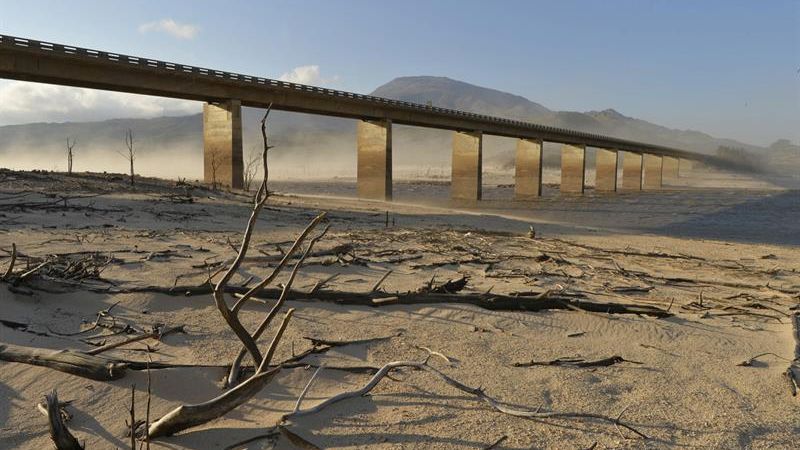OpenAI has launched GPT 5.2, a major model upgrade now available in both the API and ChatGPT. It is described as the company’s most…
Cape Town dams: Theewaterskloof Dam less than 16% full

After last week’s notable decline, the City of Cape Town has this week recorded yet another decrease to the dam levels across the Western Cape Water Supply System (WCWSS).
Dams monitored by the City now hold just 28.7% of their designed capacity, down from 29.7% the previous week. Talking actual numbers, that’s a loss of 9.3-billion litres of water in a week, enough to sustain Cape Town’s thirsty population for just over two weeks.
Overall, dam levels have dropped by 2.3% since the beginning of the year.
Cape Town’s dams
The largest reservoir in the Western Cape, the Theewaterskloof Dam, is now just 15.9% full. Less than 6% of its storage — some 48 days of water at our current consumption rate — remains usable.
The Berg River Dam was another notable loser, dropping 1.5% of its stores over the previous week. It remains at 56.5% full — one of only three dams above the 50% mark.
Steenbras Upper Dam remains above the 90% mark, but its Lower companion dropped 1.8% of its capacity to 47.7%.

While the Voëlvlei — the second largest dam in the WCWSS — fell below the 20% mark. It’s now just 19.6% full after losing 1% during the previous week.
The only dam that saw an increase was — once again — the Wemmershoek Dam, gaining just 0.1% of its capacity over the previous week. This is made more notable by the lack of rainfall in the area during the week.
Additionally, it, along with the Berg River and the Steenbras Upper, are the only dams that are currently holding more water at present than at the same point in 2017.
Water consumption increases, rain remains absent
Notably, water consumption saw a massive spike over the previous week.
From 578-million litres per day, the City of Cape Town recorded an increase of some 20-million litres per day in its latest report. Overall usage from its collection of reservoirs equates to 618-million litres per day — 118-million per day more than its target.
Cape Town’s ‘green’ map reveals water usage per household
The City of Cape Town has this week made spying on friends, family or even neighbours’ water usage habits even easier. Previously, one would have to sneakily peak over the wall when the spritz of a sprinkler was heard, but now you can simply use the City’s freely available Water Map. Read more…
Cape Town is still using less than half of what it consumed in winter 2014, but it’s still not enough.
The weather hasn’t been much help either. There was no precipitation recorded by the City between 8 January and 14 January 2018, bar a sprinkle of just 1.5mm around the Steenbras catchment area.
The report was published prior to the rainfall across the city on Monday.
The Western Cape’s dams
While the City of Cape Town has implemented Level 6 water restrictions, Stellenbosch and Saldanha are the only other two municipalities currently facing Level 5 restrictions.
Beyond this, dam storage across the province paints a dire picture.
Eight dams in the Karoo and Garden Route remain below the 10% full mark.
Larger dams outside major centres, like the Brandvlei, Kwaggaskloof and Clanwilliam, are all below the 30% mark.
Water augmentation schemes: the latest
Although Cape Town major Patricia de Lille was this week charged by the DA for misconduct, she nonetheless released a statement on 11 January detailing the progress of the City’s augmentation schemes.
Drilling to access the Cape Flats Aquifer has begun in Mitchell’s Plain. The aquifer will add an additional 80-million litres of water to the City’s system.
“The City will drill in Strandfontein, Philippi, Wesbank, Bishop Lavis and Kayelitsha[sic] to look for the best abstraction points to tap water from the Cape Flats aquifer,” she added.
The Table Mountain Group Aquifer and Atlantis Aquifer will offer an additional 70-million litres per day, de Lille noted.
There was no update on the proposed desalination plants earmarked for installation across the city.
More bad news
The City, as of Friday, has begun installing “pressure management technology” to areas across the metropole.
“Not only does pressure management generally lower consumption by reducing the rate at which water flows to properties, it also reduces leaks and pipe bursts by better ensuring that pressure remains within levels that the pipework can tolerate, and reduces the rate of loss from leaks and bursts,” it added in a statement.
“We have identified 25 areas across the city that could benefit from this technology over the next three months, and contractors have been brought in to speed up the programme.”
Day Zero is now set for 21 April 2018.
Feature image: Theewaterskloof Dam, 1 July 2017, by City of Cape Town


